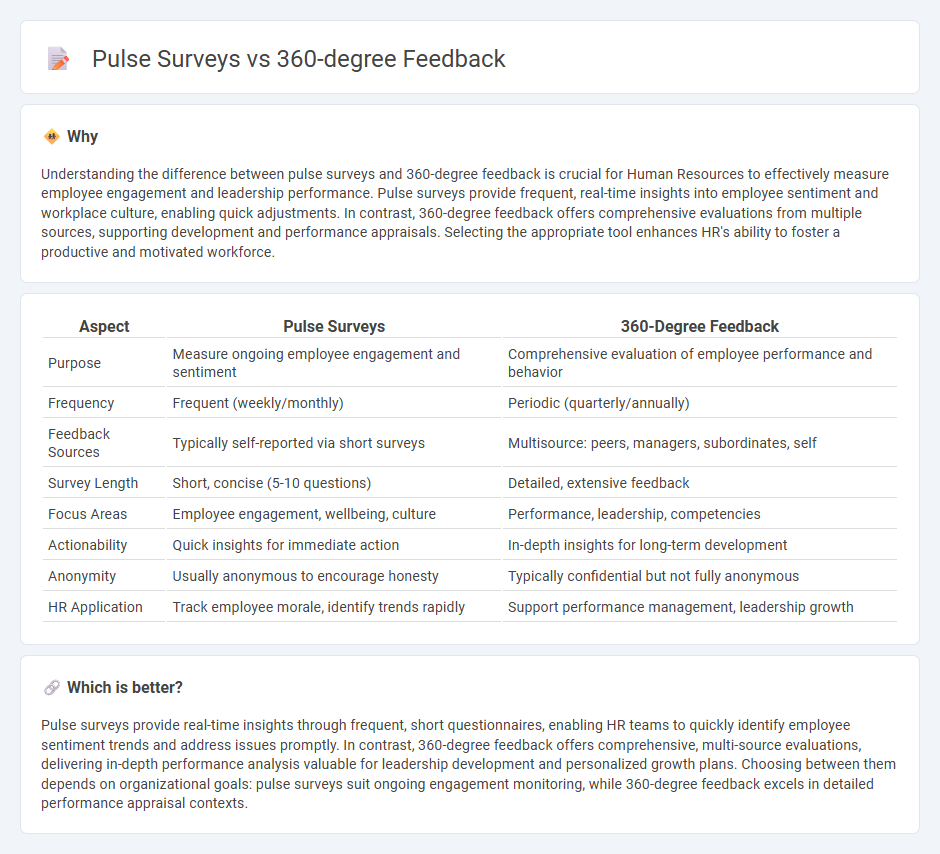
Pulse surveys offer quick, frequent insights into employee engagement and workplace sentiment, enabling HR teams to address issues in real time. In contrast, 360-degree feedback provides comprehensive performance evaluations by gathering input from peers, supervisors, and subordinates, fostering holistic employee development. Discover how integrating both methods can enhance organizational effectiveness and employee satisfaction.
Why it is important
Understanding the difference between pulse surveys and 360-degree feedback is crucial for Human Resources to effectively measure employee engagement and leadership performance. Pulse surveys provide frequent, real-time insights into employee sentiment and workplace culture, enabling quick adjustments. In contrast, 360-degree feedback offers comprehensive evaluations from multiple sources, supporting development and performance appraisals. Selecting the appropriate tool enhances HR's ability to foster a productive and motivated workforce.
Comparison Table
| Aspect | Pulse Surveys | 360-Degree Feedback |
|---|---|---|
| Purpose | Measure ongoing employee engagement and sentiment | Comprehensive evaluation of employee performance and behavior |
| Frequency | Frequent (weekly/monthly) | Periodic (quarterly/annually) |
| Feedback Sources | Typically self-reported via short surveys | Multisource: peers, managers, subordinates, self |
| Survey Length | Short, concise (5-10 questions) | Detailed, extensive feedback |
| Focus Areas | Employee engagement, wellbeing, culture | Performance, leadership, competencies |
| Actionability | Quick insights for immediate action | In-depth insights for long-term development |
| Anonymity | Usually anonymous to encourage honesty | Typically confidential but not fully anonymous |
| HR Application | Track employee morale, identify trends rapidly | Support performance management, leadership growth |
Which is better?
Pulse surveys provide real-time insights through frequent, short questionnaires, enabling HR teams to quickly identify employee sentiment trends and address issues promptly. In contrast, 360-degree feedback offers comprehensive, multi-source evaluations, delivering in-depth performance analysis valuable for leadership development and personalized growth plans. Choosing between them depends on organizational goals: pulse surveys suit ongoing engagement monitoring, while 360-degree feedback excels in detailed performance appraisal contexts.
Connection
Pulse surveys and 360-degree feedback are interconnected tools in human resources that offer continuous and comprehensive employee performance insights. Pulse surveys capture real-time employee sentiment and engagement levels, while 360-degree feedback provides multi-source evaluations from peers, managers, and subordinates to assess competencies and behaviors. Integrating both enhances talent management strategies by enabling organizations to monitor workplace climate and individual development needs accurately.
Key Terms
Comprehensive Evaluation
360-degree feedback gathers performance insights from multiple sources including peers, supervisors, and subordinates for a holistic employee evaluation. Pulse surveys provide frequent, short check-ins that capture real-time employee sentiment and engagement levels. Explore how integrating both tools enhances your organization's talent management strategy by visiting our detailed guide.
Continuous Feedback
360-degree feedback collects comprehensive evaluations from multiple sources including peers, managers, and subordinates to provide a holistic view of employee performance. Pulse surveys deliver real-time insights through brief, frequent questionnaires, enabling organizations to monitor employee engagement and satisfaction continuously. Explore how integrating both approaches enhances continuous feedback strategies and drives organizational growth.
Real-Time Insights
360-degree feedback gathers comprehensive evaluations from multiple sources, offering a holistic view of employee performance over a set period. Pulse surveys deliver frequent, real-time insights into employee sentiment and engagement, allowing organizations to quickly identify and address issues. Explore how combining these tools can enhance your talent management strategy.
Source and External Links
What is 360 Degree Feedback? - CustomInsight - This webpage explains 360-degree feedback as a comprehensive assessment system where employees receive evaluations from various stakeholders, including managers, peers, and direct reports, to enhance self-awareness and employee development.
360 Degree Feedback: Process, Examples & Template - Personio - This guide provides insights into implementing a 360-degree feedback process, including examples of feedback questions and templates to enhance performance management.
360 Degree Feedback: A Comprehensive Guide - AIHR - This article offers a detailed overview of 360-degree feedback, its benefits, and best practices for implementation to improve employee performance and development.
 dowidth.com
dowidth.com